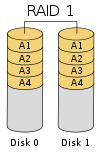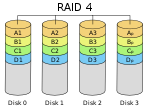A Redundant Array of Independent Drives (or Disks), also known as Redundant Array of Inexpensive Drives (or Disks) (RAID) is an term for data storage schemes that divide and/or replicate data among multiple hard drives. RAID can be designed to provide increased data reliability or increased I/O performance, though one goal may compromise the other.
There are total 10 types of RAID levels:
- RAID level 0
- RAID level RAID level 1
- RAID level 2
- RAID level 3
- RAID level 4
- RAID level 5
- RAID level 6
- RAID level 10
- RAID level 50
- RAID level 0+1
Commonly used RAID levels for UNIX / Linux and Windows server
Following are commonly used RAID levels :
| Level | Description | Minimum # of disks | Space Efficiency | Fault Tolerance | Read Benefit | Write Benefit | Image |
|---|---|---|---|---|---|---|---|
| RAID 0 | Block-level striping withoutparity or mirroring. | 2 | 1 | 0 (none) | nX | nX |  |
| RAID 1 | Mirroring without parity or striping. | 2 | 1/n | n−1 disks | nX | 1X |  |
| RAID 2 | Bit-level striping with dedicatedHamming-code parity. | 3 | 1 − 1/n ⋅ log2(n-1) | 1 disk when the corrupt disk is found by the ( ) recover-record code. |  | ||
| RAID 3 | Byte-level striping with dedicated parity. | 3 | 1 − 1/n | 1 disk |  | ||
| RAID 4 | Block-level striping with dedicated parity. | 3 | 1 − 1/n | 1 disk |  | ||
| RAID 5 | Block-level striping with distributed parity. | 3 | 1 − 1/n | 1 disk | (n−1)X | variable |  |
| RAID 6 | Block-level striping with double distributed parity. | 4 | 1 − 2/n | 2 disks |  |



0 Comment:
Post a Comment